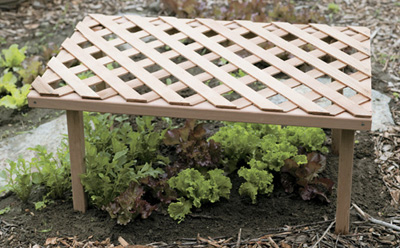 " twist drill bit
" twist drill bitMATERIALS
Lumber
2"×2" cedar balusters (five 36" lengths)
Lattice (20½"×35¾")
Supplies
4d galvanized box nails (30 or so)
Four 2½" screws (for attaching the legs)
Tools
Tape measure
Pencil
Combination square
Wood saw
Power drill
 " twist drill bit
" twist drill bit
Driver bit to match screws
If you like to sow lettuce every couple of weeks for season-long harvesting, this shade cover can be a big asset for plantings during the hotter summer months. By filtering the sunlight, the screen helps prevent the lettuce from quickly going to seed and becoming bitter.

LATTICE SHADE COVER. Equipped with collapsible legs, this wooden screen is easy to store when you’re not using it.
Cutting the lumber. From the 2"×2", reserve two 36" lengths for the front and back of the cover frame  . From the remaining 2"×2", cut two 17¾" lengths for the sides
. From the remaining 2"×2", cut two 17¾" lengths for the sides  . Also cut four 16¾" lengths for the legs
. Also cut four 16¾" lengths for the legs  and round the corners (this will keep the leg tops from rubbing on the lattice when you collapse the shade cover for storage at the end of the season).
and round the corners (this will keep the leg tops from rubbing on the lattice when you collapse the shade cover for storage at the end of the season).
Constructing the shade cover. Make up the frame by attaching the front and back  to the sides
to the sides  . Attach the legs
. Attach the legs  with single screws, as shown in fig. 1, so that they will pivot. Then attach the lattice to the top of the frame.
with single screws, as shown in fig. 1, so that they will pivot. Then attach the lattice to the top of the frame.
FIG. 1
Keep It Cool
Not all plants like full sun. Spinach, for example, doesn’t germinate well in very warm soils. Placing a shade cover over a planting area a week ahead of time can help moderate the temperature. It’s also a good idea to shade the emerging seedlings and young plants during hot spells (above 80°F/27°C) to prevent wilting and bolting. Lettuce, too, should be kept partially shaded when grown in warm weather.